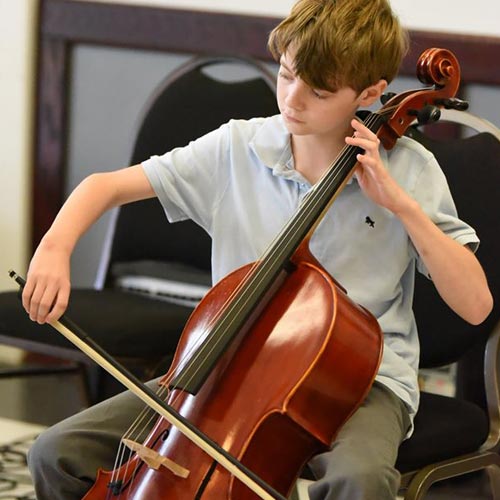Learn to Play Cello
The Cello has enjoyed widespread pubic attention in recent years, most likely due to high profile performers such as Yo Yo Ma and Apocalyptica. Also known as the Violoncello, our third core Stringed Instrument that falls even lower in pitch than the Viola. Larger in size than both the Violin and Viola, the Cello produces a lower, rich, sonorous sound much like a Contra Bass and has figured prominently in Classical Music since the Baroque Period. The School of Music offers Cello Lessons for all ages. Our Instructors use a variety of Methods as well as repertoire and exercises as foundation for study.
The Cello as well as other parts of the Violin Family, began it’s development in Northern Italy in the Early 16th Century. Although it’s widely believed to have been derived from the Viola de Gamba, the Cello actually existed at the same time for more than two Centuries. Most likely, the Cello was derived from the Bass Violin which was in turn invented in around 1538. Around 1700, Italian Cellists began to help the popularize the instrument in Northern Europe. Since then, many Solo, Quartet, Chamber, and Orchestral Works have emerged for the Cello. Composers such as Bach, Tchaikovksy, Beethoven, Brahms, and many others have written important works featuring this classic instrument.
Traditionally, Cellos are made of a spruce top and maple back / sides. However, they can be made of other types woods including poplar, willow, or even laminate. Like other string instruments Cellos use a bow made of horse hair, however the player plays seated with the Cello held between their knees. In terms of tuning, Cellos are tuned in 5ths, to C-G-D-A, thus putting it exactly an octave below the Viola in pitch. As for reading Musical Notation, the Cello uses Bass, Tenor, and Treble Clefs depending on the range of the Music being played. For younger students, the Cello does come in fractional sizes as well as the standard full size.
Private cello lessons are offered on a weekly basis and provide:
- One-on-one interaction between student and instructor
- Highly personalized learning program
- Individual attention and pace
- More direct tracking of progress
- More flexible scheduling



